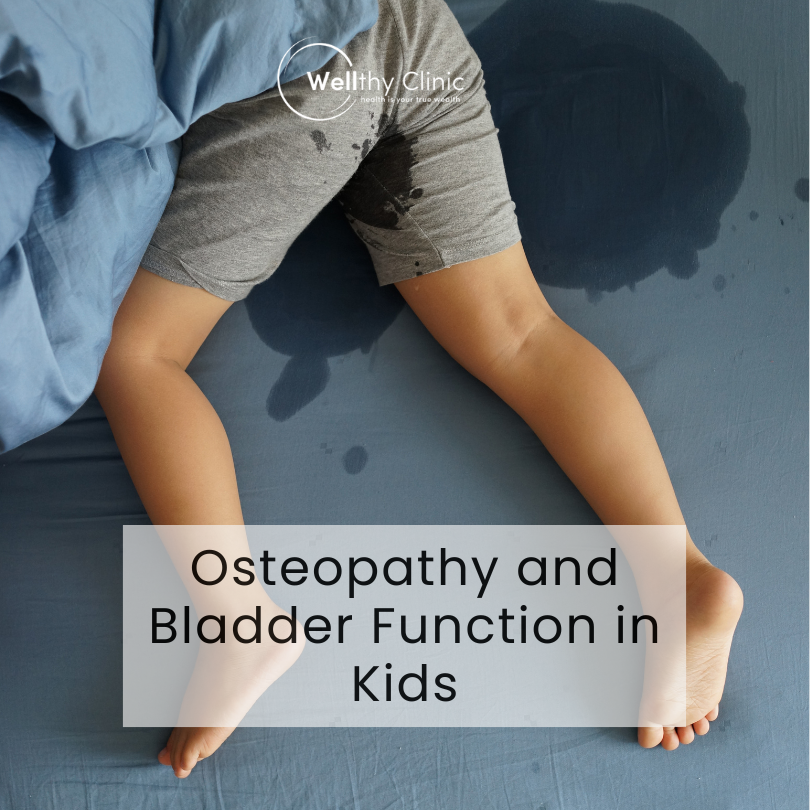Understanding Enuresis (Bedwetting): Causes and Management Options
Enuresis, commonly known as bedwetting, is a prevalent condition among children, typically resolving with age. However, when enuresis persists beyond early childhood, it can cause distress to both the child and their family. Primary nocturnal enuresis (PNE) refers to involuntary urination during sleep in children who have never achieved consistent nighttime bladder control for at least six months. The causes of enuresis are multifactorial, involving genetic, hormonal, neurological, psychological and musculoskeletal factors. Understanding these contributors is essential in determining an effective treatment strategy.
Causes of Primary Nocturnal Enuresis:
Genetic Factors
Research indicates a strong hereditary component in enuresis. Children with a family history of bedwetting are more likely to experience similar issues. Studies suggest that if one parent had enuresis, the child has a 40% chance of developing the condition, which increases to 70% if both parents were affected.
Hormonal Imbalance
Antidiuretic hormone (ADH), also known as vasopressin, plays a vital role in regulating urine production. At night, ADH levels typically rise reducing urine output. However, some children with enuresis exhibit inadequate secretion of ADH, leading to increased urine production at night, overwhelming the bladder's capacity.
Delayed Bladder Maturation
Some children have a delayed ability to control bladder function at night. This immaturity in the nervous system may prevent them from waking up when their bladder is full, resulting in involuntary urination.
Psychological and Emotional Factors
Anxiety, stress and emotional trauma can contribute to enuresis. Studies have shown a correlation between high stress levels and increased episodes of bedwetting. Children with social anxiety or phobias, such as fear of public transport or crowded places may exhibit symptoms of enuresis as part of their broader anxiety response.
Constipation and Gastrointestinal Dysfunction
The close anatomical relationship between the rectum and bladder means that chronic constipation can exert pressure on the bladder, reducing its capacity and increasing urgency. Studies indicate that up to 50% of children with enuresis also experience constipation. Addressing underlying digestive issues and constipation is essential for managing enuresis (Baby digestive issues and cranial osteopathy).
Obstructive Sleep-Disordered Breathing
Conditions such as enlarged tonsils and adenoids can cause sleep apnea, leading to poor sleep quality and reduced arousal response. Children with sleep-disordered breathing have been found to have a higher prevalence of enuresis, with some studies suggesting symptom resolution following surgical intervention.
Neurological and Attention-Deficit Hyperactivity Disorder (ADHD)
There is a well-established link between ADHD and enuresis. Children with ADHD are three times more likely to experience persistent bedwetting. Impulsivity, inattentiveness, and hyperactivity may contribute to difficulties in recognising bladder fullness during sleep.
Urinary Tract Infections (UTIs)
Although less common in primary enuresis, UTIs can present with increased urinary urgency and frequency, sometimes mimicking enuresis symptoms. Ruling out infections through urine analysis can be a valuable step in the diagnostic process.
Complementary Approaches in Enuresis
Management of enuresis often involves a combination of behavioural strategies, lifestyle adjustments and, where appropriate, medical input. This may include bladder training, bedwetting alarms, constipation management, sleep hygiene, and reassurance as a child develops.
Some families also choose to explore complementary approaches alongside conventional care. Manual therapies, such as paediatric osteopathic care, are used by some parents as part of a broader support plan. These approaches focus on overall movement, comfort and wellbeing rather than treating bedwetting in isolation.
Pelvic Alignment and Bladder Function
Proper pelvic alignment is crucial for optimal bladder function. The bladder relies on the structural integrity of the pelvis and pelvic floor muscles for support. Misalignment or asymmetry in the pelvis can impact bladder control, contributing to enuresis and cranial osteopath for back pain.
Autonomic Nervous System Regulation
The autonomic nervous system (ANS) plays a critical role in bladder control. Increased sympathetic nervous system tone (commonly found in children with high levels of stress or anxiety) can result in an overactive bladder. Osteopathic treatment focuses on balancing the sympathetic and parasympathetic systems to promote normal bladder function.
Brainstem Maturation
The brainstem regulates the micturition reflex, and any maturational delays in this area can contribute to enuresis. Cranial osteopathy could be beneficial in improving nervous system function by addressing restrictions in the cranial bones and membranes.
Thoracic and Lumbar Spine Mobility
The spinal nerves that innervate the bladder originate from the lower thoracic and lumbar spine. Restrictions in this region can impact neural signalling to the bladder, potentially contributing to enuresis. Osteopathic treatment can help restore mobility and improve nerve function.
Diaphragmatic Function and Respiratory Patterns
The diaphragm is closely linked to the autonomic nervous system and to the regulation of intra-abdominal pressure. Dysfunction in the diaphragm can influence bladder control by altering pressure dynamics and affecting the pelvic floor muscles. Osteopathic techniques to improve diaphragmatic function can be beneficial in managing enuresis.
Conclusion
Primary nocturnal enuresis is a multifactorial condition influenced by developmental, hormonal, neurological and emotional factors. In many children, bedwetting improves naturally over time, although support may be helpful where symptoms persist.
Management typically focuses on behavioural strategies, addressing contributing factors such as constipation or sleep disturbance, and seeking medical advice where appropriate. Families interested in complementary approaches may explore these as part of a wider, individualised care plan.
Matthew Glithero DPO
Is the co-founder of Wellthy Clinic. A paediatric Osteopath specialist who is passionate about helping children who experience enuresis (bedwetting).



